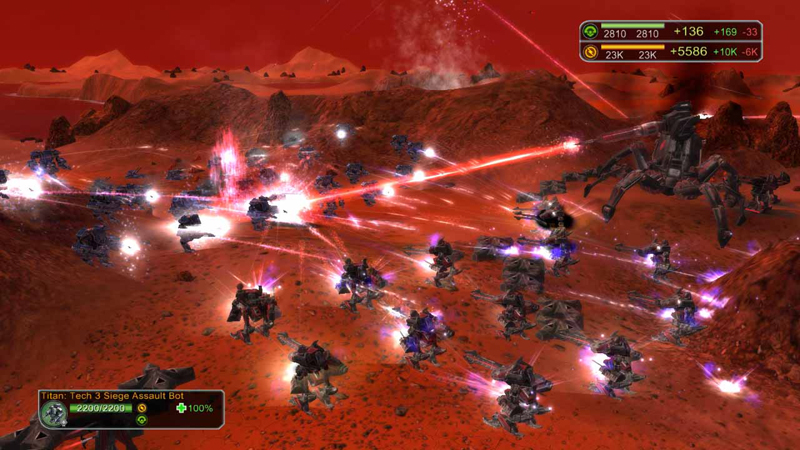eal-time strategy, said designer Chris Taylor to GameSpy three years ago, "should have been called 'real-time tactics' with a dash of strategy thrown in." All to better a genre, Taylor and developer Gas Powered Games created Supreme Commander, "an enormous theatre of war . . . that absolutely [requires] the player to think strategically before attempting to deploy [units] into the field." An early-2007 release for PC met critical approval. Sixteen months later, an Xbox 360 port is the most telling avowal of Taylor's and Gas Powered's "aim to change the definition of RTS games."
Supreme Commander's plot is one of borrowed interest, though introducing players to a familiar narrative has practical advantages.

Think on a scale of magnificence.Recite with me: human beings discovered faster-than-light travel, built an empire leap by leap across the galaxy and entered a halcyon age. Man and fate collided and the domain was shattered by war. Centuries later three powers — imperialists, cyborgs and a xeno-cult — remain in a bid for supremacy.
Whereas Stardock's recent Sins of a Solar Empire employed an inevitable trio of races merely to differentiate one unit set from another, Supreme Commander not only features a single-player campaign but directs it along a coherent storyline.
Mechanics are, likewise, canonical real-time strategy. A player draws natural resources to produce machines of progressively greater size and complexity; engages the enemy over land, in the air and on the sea; and completes objectives ranging from total destruction, to delicate capture and recovery, to mindful safeguarding and escort. Gas Powered's additions to the formula are, however, all notable.
The first is the ACU — a kind of colossal Starcraft SCV — serving as a primary constructor as well as a capital unit and manifestation of the player's character. Second is a zoom that scales at any level between the entire battlefield — armies functionally represented, like Avalon Hill game pieces — and an individual vehicle or structure. Third is a range of movement and action queuing options to satisfy the most punctilious micromanager.
And yet Supreme Commander's gameplay contradicts its premise. Engagements invite, and missions necessitate, methodical and thoughtful play — marshalling a combined force, maneuvering it into position and executing an attack with deliberation. Of course, competence is essential. But on any setting other than easy, Supreme Commander demands play that is nothing less than faultless and frantic.
Alec Meer of Eurogamer was right when he called the game "hard work" — it will challenge RTS adepts and overwhelm nearly anyone else. Battalions, wings and flotillas charge out of nowhere, as arbitrarily as in a shooter, the strategic equivalent of a chess opponent upending a boxful of pawns onto the board mid-game. With hardly a moment to think, one consigns the game's many choices, formations and battle plans to an unfortunate surplus from a well-meaning Chris Taylor.

Everything happens so fast:
there's no time to savor brilliance.Worse, theatrics compel haste. Allies and opponents appear on-screen about every seven minutes, chiding you to hurry it up already. Hearing this over and over, while another enemy multitude envelops your command, is — and I am focusing every ounce of strength to euphemize — particularly unhelpful. More than once I told a supporting character, in a very loose paraphrase, to be silent.
Supreme Commander shows a few wrinkles in its Xbox 360 release. Players accustomed to hotkeys on the PC release may find button-and-stick combinations inconvenient, or even prohibitive; while the enormous armies potentially fielded by high-end computers may more quickly exceed the 360's processing limitations, as slowdowns were apparent long before the publicized maximum of one thousand units. There is at least one bug, not flagrant but frequent enough for mention: during a dozen or more hours of play, four game-saves each caused a crash. The television screen began flickering the first time; the second and third, it just went black; and the fourth time, weirdly, I could survey the map and select units but every object was frozen.
Still, cross-platform technicalities are eclipsed by Supreme Commander's proposition, "strategy in a big way." Have Taylor and Gas Powered Games successfully introduced elements to real-time strategy gaming? They have. Enough for redefinition? No, and Taylor et al ran aground on what motivated Supreme Commander in the first place — not so much an obstacle as an axiom. Beyond a certain speed and intensity of gameplay, RTS gives players every reason to skip intricacy or genius, and go straight for the expedient. In other words, tactics over strategy.









































